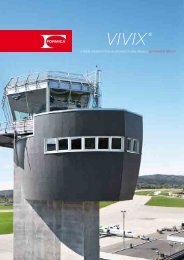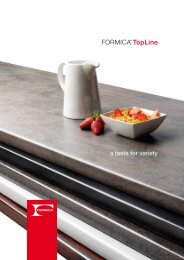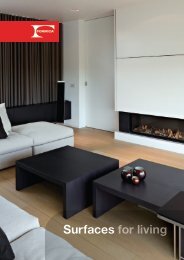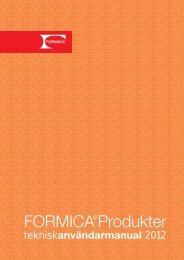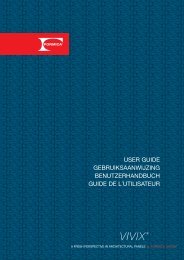Technical Information dispelling traditions - Formica
Technical Information dispelling traditions - Formica
Technical Information dispelling traditions - Formica
Create successful ePaper yourself
Turn your PDF publications into a flip-book with our unique Google optimized e-Paper software.
formica_technical.qxd:formica_technical.qxd 28/11/08 16:01 Page 21ApplicationDesign ConsiderationsThe inherent characteristics of decorative laminates impose certaindesign restrictions. Some of these are outlined below. If you haveany question concerning design and application please contact ourFabrication Support Unit (FSU).Sheet sizes<strong>Formica</strong> ® decorative laminates are produced in a variety of sheetsizes, but not all grades/patterns/colours are available in all sizes.When selecting a laminate please check availability of sheet size.Due consideration should be given to specifying the mosteconomical sheet size in order to minimise material wastageduring cutting.Design featuresSheets with geometric or linear features may need a dressingcut to properly align and position the feature relative to theedge of the panel.Dimensional movementHigh-pressure decorative laminates are cellulose-based materialsand therefore, like any wood-based materials, they shrink in dryconditions and expand in wet conditions. Precautions shouldtherefore be taken to prevent cracking or adhesive bond failuredue to dimensional movement.Stress crackingIn conditions of low humidity caused by central heating,or of localised heating by radiator grilles or hot air vents,shrinkage may occur which can result in cracks from highstress points such as sharp internal corners or chipped edges.Stress cracking is the result of stresses set up when thedimensional movements of the laminate and of the substrateto which it is bonded, are different in either rate or direction.Stress cracking occurs most often when contact adhesives areused, as these adhesives are elastomeric (i.e. non-rigid) and allowthe laminate to creep. To reduce the risk of stress cracking, thefollowing measures should be followed:1. Internal corners of apertures and cut-outs must always besmoothly radiused to as large a radius as possible. The minimumradius is 5mm, but this should be increased for apertures withlarge side lengths.2. If sharp internal corners are required as a design feature, theseshould be formed by butt-jointing panels, and not by right-angledcut-outs.3. All cut edges should be smooth, with no chipping.4. The use of contact adhesives should be avoided, particularly wherethe ambient conditions in the final installation are warm and dry.5. Where contact adhesive is used (particularly when handapplied),panel widths should not exceed 600mm. Where widerpanel widths are required, these must be fabricated using rigidor semi-rigid adhesives.6. In order to minimise dimensional movement, the longestdimension of the panel should be cut in the length directionof the laminate sheet, i.e. parallel with the sanding lines; as laminatemovement is approximately twice as great across the sheet widthas it is along the length.7. The laminate should be pre-conditioned in temperature/humidityconditions similar to those of the final installation, for at least threedays prior to bonding. This is particularly important if the laminatehas a high moisture content, following storage or transport in highhumidity conditions.8. Drilled holes for fixing screws, etc. should be oversize, to ensurethat fixings do not impinge on the edge of the laminate.9. The panels should be fixed firmly to prevent any bendingor twisting which may cause stress.<strong>Formica</strong> Limited, Coast Road, North Shields, Tyne & Wear NE29 8RE. Tel: 0191 259 3000. Fax: 0191 258 2719.<strong>Formica</strong> is a registered trade mark of <strong>Formica</strong> Corporation or its subsidiaries.<strong>Technical</strong> Services Department April 2004.20




